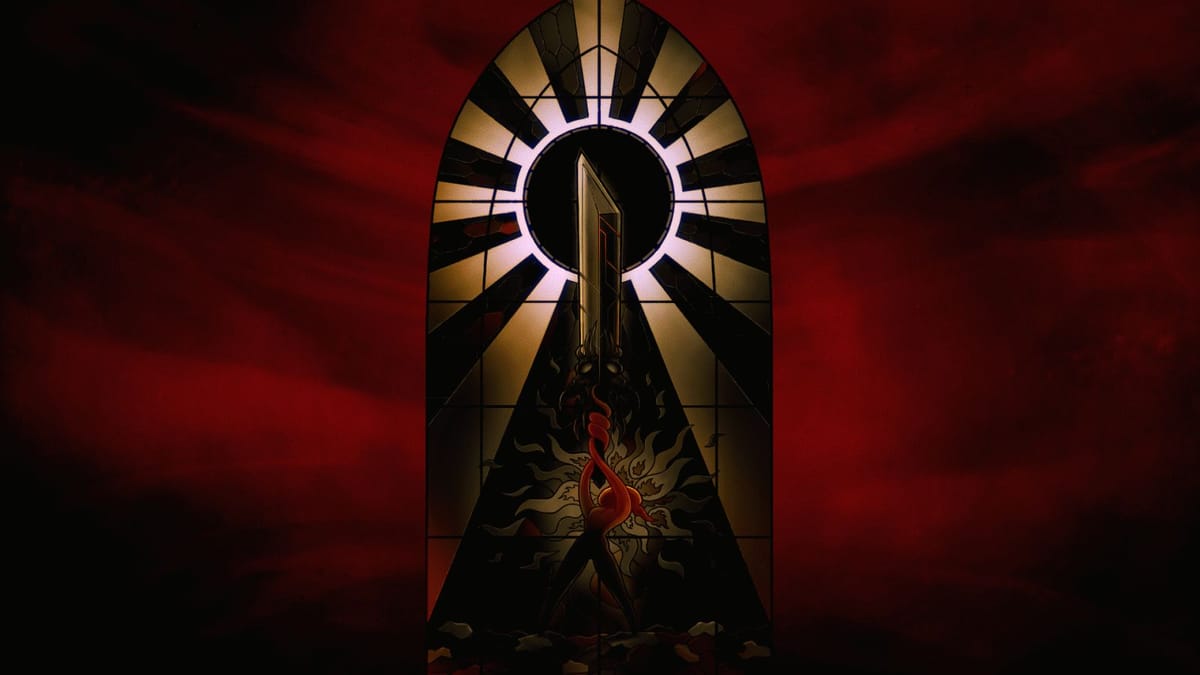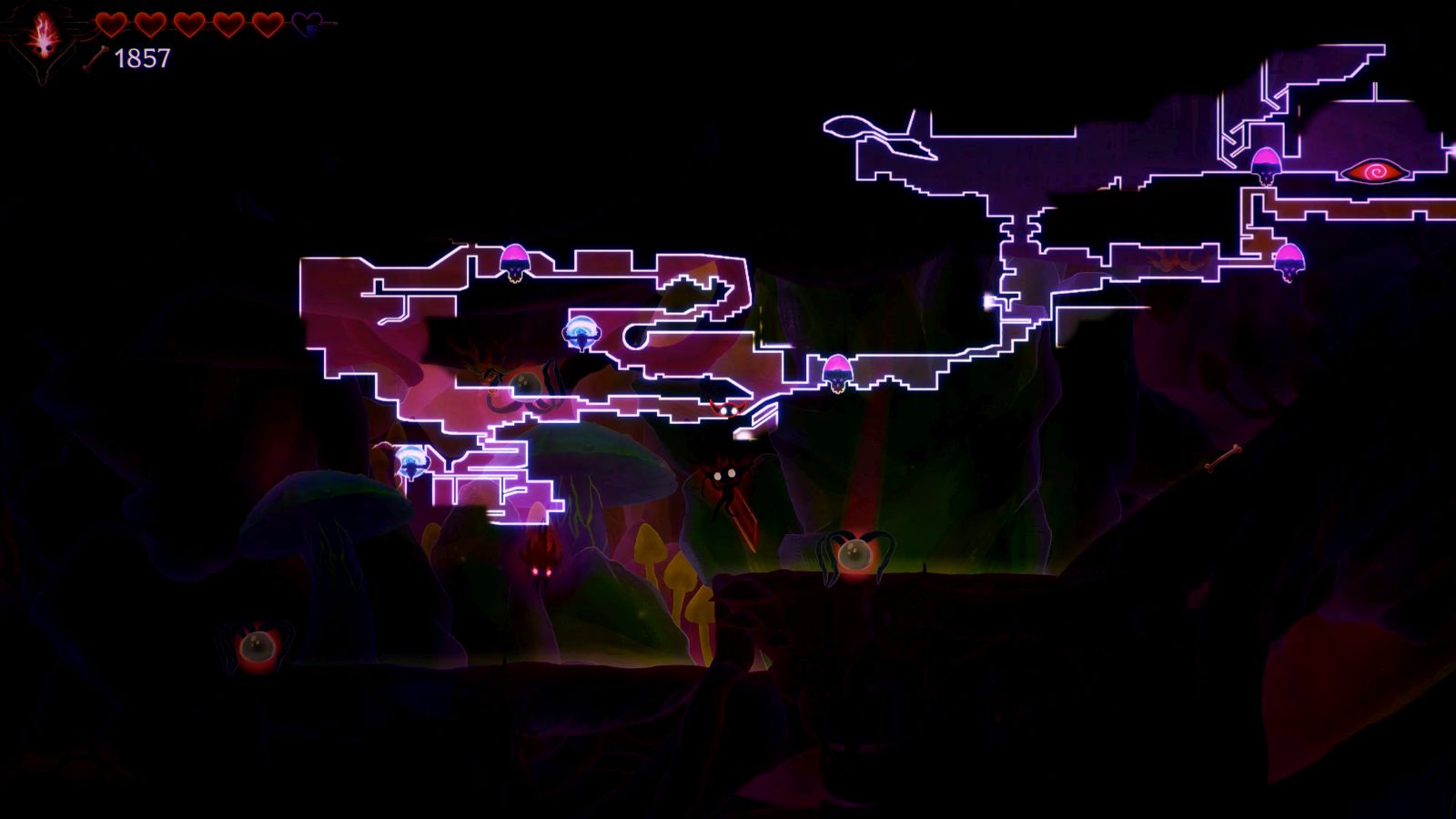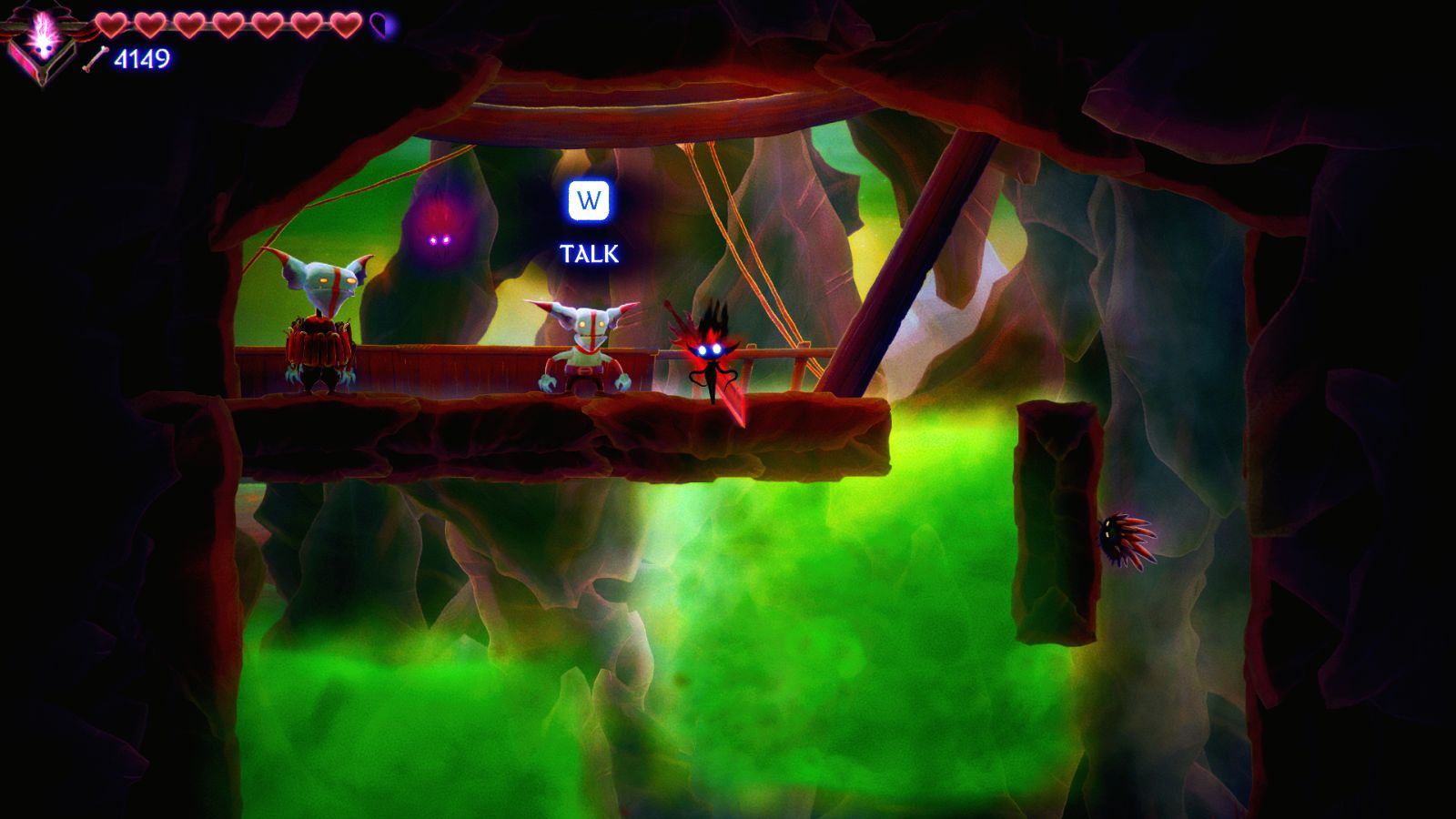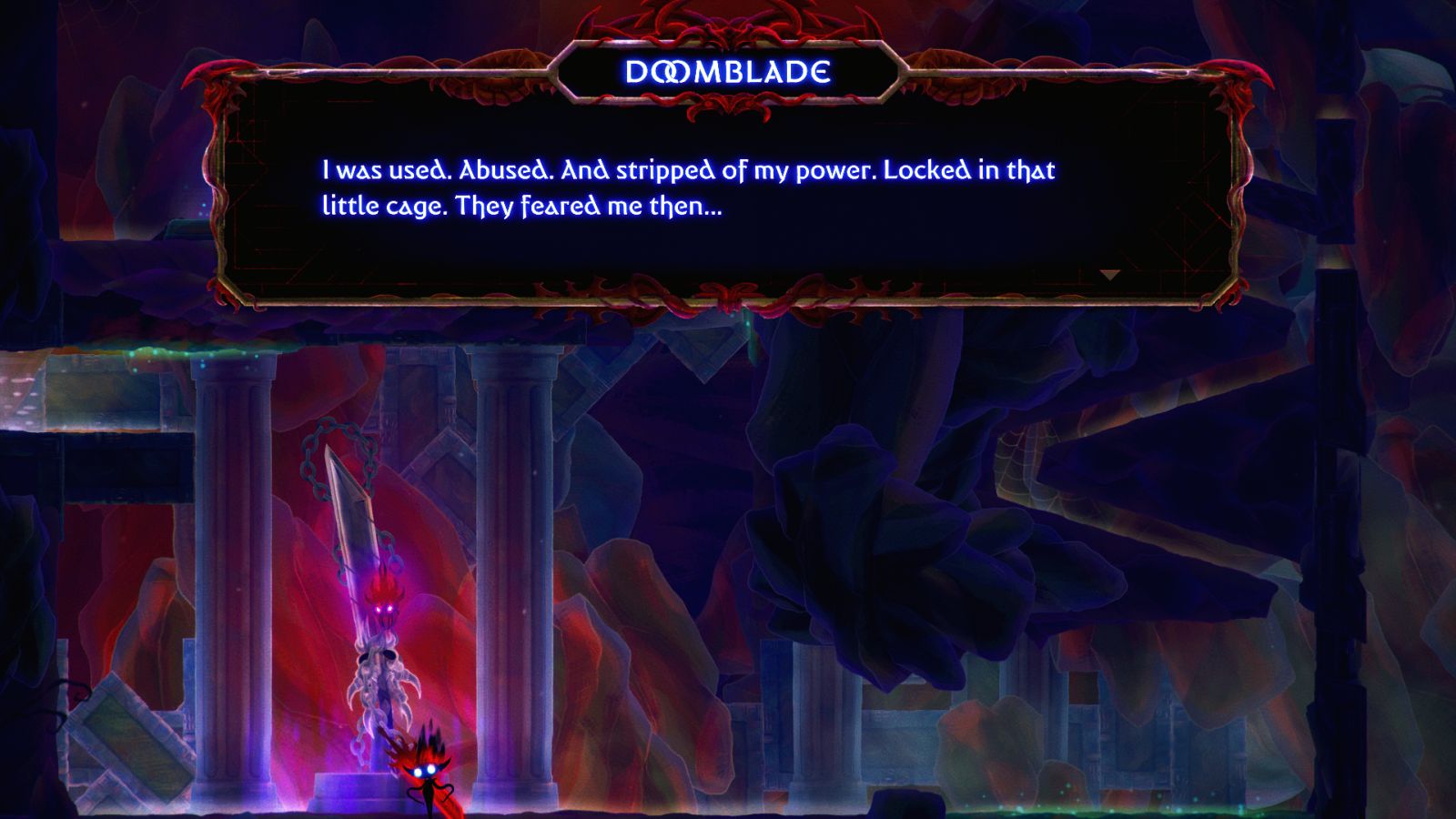
Who doesn’t love a good revenge story? There’s something deep within people, something primal, that really gets a kick out of watching the bad guys get what’s coming to them. DOOMBLADE is a brilliant Metroidvania with style, heart, and some good old-fashioned revenge.
You barely know Gloom, a little Hopkinsville goblin lookin’ creature before she finds a sentient cursed blade and decimates a bushel of foes. Apparently, she’s a gloomling, a rather pathetic creature with a poor excuse for a jump in a world of 2D platforming. That’s where the cursed sword, Doom, comes in handy. Pointing the sword at an enemy causes Gloom to lunge forward, gaining much more distance than she could with her jump alone.

As I progressed, a clear story of hierarchy was established. It adds context for why Gloom thought, “Yeah, I could go for some killing,” the second she picked up a cursed sword. To sum up, the evil forces in power, the Dread Lords, enslaved the gloomlings in the mines, and Gloom is the last of her kind; now it’s time for some vengeance. Gloom and the Doom have mutual interests, as the blade’s powers were stripped from it by the Dread Lords.
While Doom seems ominous, the Dread Lords are definitely the bad guys. You can find their edicts scattered throughout the map with recommendations such as eating one’s lovers, children, and own flesh as a means of sustenance in times of famine. They’re not just evil, they’re comically evil, which helps to lighten the mood in such an oppressive world.

DOOMBLADE’s gameplay is fast-paced. Gloom is propelled like a bullet from enemy to enemy by clicking on them. The lunge attack serves as a platforming tool, but when you’re grappling toward a creature with crystal spikes protruding from its back, then you have to be a little more precise with where you aim. When you execute is equally important, you don’t want to miss your platform after all. All in all, your ability to click accurately and at the right time makes up the vast majority of combat prowess.
Another way to increase Gloom’s power level is to unlock more abilities, which in turn, unlock more parts of the map. Sure it’s a Metroidvania, and this kind of mechanic is expected, but the way DOOMBLADE completely shifts the way you see the game makes the world feel engaging and dynamic. When Gloom learned to phase through terrain to attack enemies on the other side, it genuinely felt like a breath of fresh air, especially in the cramped mines. The game really nails the feeling of going from a small, pathetic creature, to a powerful, dark force.
The world is large, and it can be a hassle to get from one end to the other, especially as you progress through the game. That’s where the void comes in, a separate realm accessed through portals that serve as fast travel. In the void, you latch onto a floating squid creature, and it whisks you away to another side of the map, where you enter another portal to return to the world. It’s much more interesting than the simple ‘click and accept’ fast travel, but the void network feels lacking and it’s not completely interconnected.

Despite the game’s efforts, backtracking felt like a slog after a while. Firstly, the world is large, with some areas being long, isolated paths, so finding your way back to a void portal takes some time. Secondly, some areas are mired in puzzles. DOOMBLADE is at its best when you’re engaging in one of the many interesting combat encounters, flying through the air from enemy to enemy with an immaculate rhythm. Instead, I would have to go through puzzles that didn’t feel rewarding to complete. The puzzles definitely felt like padding at times.
There is a map, but the game rarely if ever tells you which direction you can go to progress. I’m all for nonlinearity, but the game doesn’t provide the player with enough information to keep them on the right track. The soul motivation in the story is to slay the Dread Lords and not much else. Meanwhile, the main allure of the gameplay is the combat and bosses, so when one or two boss fights simply miss, it can leave the game feeling like it’s lost some steam.
Thankfully, the game’s sense of humor and worldbuilding would always pick up the slack; it’s charming in its own, vile way. For example, at one point I had to travel through a path full of poison gas. It was avoidable, but it sure would make my life easier if there were a way to negate it. Luckily, I came across some goblin creatures who were all for overthrowing the Dread Lords and wanted to support the cause. They promised they could help me deal with the poison; for a small price of a few hundred bones of my vanquished enemies, the common currency. I gladly accepted the deal, to which one of the goblins self-destructed with dynamite, and the other goblin gave me consent to consume the dead goblin’s lung. This lung gave me the ability to negate the poison! It was odd, dark, and whimsical, DOOMBLADE in a nutshell really.

While exploring the world, you’ll occasionally come across shops. Most of the time you have to buy fragments of items that come together to increase a stat like damage or health. It’s immensely helpful because it means you can brute force some puzzles or encounters. However, It’s annoying that I have to buy pieces of an item instead of buying it outright. It never felt rewarding to spend a huge amount of currency on one-fourth of what I needed for a useful upgrade. I would rather have to save up a lot of bones and make a tough choice between increasing my damage or health.
DOOMBLADE’s aesthetics are mystical and dark. There’s something sickly about the art style with its hazy greens and reds. There’s really good diversity in level design too. It has mechanical labyrinths with oscillating gears, and dense jungles with plants that pulsate, giving them a hallucinogenic look.
The characters themselves are also distinct. The tip taps of Gloom’s appendages as she moves sells her as an uncanny creature. Doom, despite just being a sword, is represented by the cursor, an eldritch-looking face. When you click, the face pulses with dark energies of red and black. It’s little details like these that make the world feel so fleshed out.

I would be committing a crime if I failed to mention the music. Sure, there’s the powerful metal sound that accompanies boss fights, but it’s the eerie chiming of the quieter areas that really breathes life into the game. Even when the backtracking felt a little burdensome, I was always accompanied by killer tunes.
Overall, DOOMBLADE is an enchanting experience, with only a few minor frustrations in exploration holding it back. The combat is fast-paced, dynamic, unique, and accompanied by great music and a beautiful backdrop with lore to match. If any of this interests you, then you can grab it for $14.99.
DOOMBLADE
Great
DOOMBLADE offers fantastic combat, lore, and art direction which propel it to greatness. Despite progressing and backtracking being confusing and tedious at times, and a few lackluster boss fights, the occasional dullness was alleviated by great music and worldbuilding that spurs intrigue. The devs created a world that I was continuously getting lost in, both literally and figuratively.
Pros
- Combat feels fast and fun
- Amazing soundtrack
- Beautiful artwork in a stellar world
Cons
- Backtracking can get tiring
- Very few indicators on where to go
- Some combat encounters are just tedious
